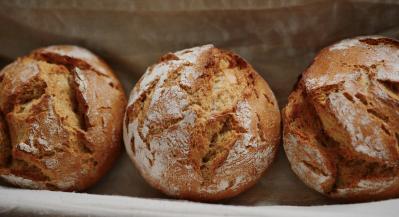
Analysis of baked goods
Baked goods are an important part of our culture and tradition. From classic bread to crispy cookies, such as bread rolls and fragrant croissants, to delicious cakes, cookies and fine tarts, baked goods offer a variety of flavors and textures that tantalize our senses.
Through detailed analysis in laboratories, bakeries and pastry shops can improve their products, for example by optimizing recipes or using alternative ingredients to meet customer demands for healthier or allergen-free options. An important aspect of this is checking the coumarin content in products containing cinnamon, as excessive amounts can pose health risks.
The accredited laboratories of the Tentamus Group will be happy to provide you with advice and support in order to offer your customers a delicious and safe taste experience for baked goods and pastries.
Challenges for producers and distributors of baked goods
Bakeries and other companies that offer baked goods such as bread and cookies must ensure the quality of the products they offer. Producers are faced with challenges such as labeling, shelf life and contamination of baked goods, which vary depending on the type of product. The distribution channel (e.g. retail or e-commerce) in turn has an influence on the shelf life requirements of the products.
In particular, these are
Allergens: bakery products may contain allergenic ingredients such as wheat, milk, eggs, nuts or soy, which can trigger allergic reactions in some people. Producers and distributors must ensure that allergens are correctly identified and that baked goods are protected from cross-contamination.
Labeling: Correct labeling of allergens is crucial to enable consumers with allergies to choose baked goods safely. However, the correct labeling of ingredients and nutritional information is also mandatory for packaged baked goods.
Acrylamide: Acrylamide is a chemical compound that can be formed at high temperatures during the baking process. This applies in particular to dry, starchy foods such as potato products, cereal products and baked goods. As acrylamide is classified as possibly carcinogenic to humans, many countries and authorities have taken measures to reduce the formation of acrylamide in food.
Mycotoxins: Mycotoxins are toxic substances produced by certain molds. These molds can grow on various foods, including grains and nuts, that are used as ingredients in baked goods.
Coumarin: Coumarin, a natural ingredient in cinnamon, can be harmful to health if consumed in excess. Marketers of baked goods are therefore faced with the challenge of monitoring the coumarin content and complying with legal maximum levels in order to ensure the safety of their products.
Shelf life and storage: Baked goods are often perishable products with a limited shelf life. The challenge is to ensure that bakery products reach consumers fresh and in perfect condition. This includes maintaining the correct storage temperature and humidity and minimizing losses due to damage or spoilage.
The requirements and challenges vary greatly depending on the product type. Bread and other fresh baked goods have different requirements than cookies and dry baked goods.
The accredited laboratories of the Tentamus Group are happy to assist you with all challenges relating to product safety, labeling and analysis of baked goods.

Necessary tests for the analysis of baked goods
Pesticides/residue analysis
Residue analysis is used to detect potentially harmful contaminants in baked goods, such as heavy metals and pesticide residues. Acrylamide residues can also be tested here. Analysis techniques such as atomic absorption spectrometry, liquid chromatography (HPLC) or mass spectrometry are used here.
Microbiological contamination
During the production and storage of baked goods, various germs can spread, including yeasts and molds that form mycotoxins.
The formation of mycotoxins depends on various factors, including the environmental conditions during harvesting, storage and processing of the raw materials. If the cereal grains or nuts are contaminated with molds during cultivation or storage and these molds produce mycotoxins (e.g. aflatoxin), the toxins can enter the food.
Yeasts are microscopic fungi that are responsible for fermentation in baked goods. However, yeast formation can also occur outside the desired areas. For example, if doughs are not cooled or stored properly, unwanted yeasts can develop and affect the quality of the baked goods. Uncontrolled growth of yeasts can lead to undesirable changes in taste, excessive fermentation or even the formation of mold.
To find out and ensure that baked goods are free from microbiological contamination, microbiological analyses of baked goods are carried out in accredited laboratories. The Tentamus Group has laboratories worldwide that are happy to support you in the quality assurance of your products.
Chemical analyses
Various chemical analyses are carried out on bakery products to obtain information about their composition, quality, nutritional properties and safety.
Coumarin: Coumarin analysis in baked goods using LC-MS/MS (liquid chromatography coupled with tandem mass spectrometry) enables precise and reliable determination of the coumarin content. The method is characterized by its high sensitivity and selectivity, as it can clearly identify and quantify coumarin, even in complex food matrices such as baked goods or cinnamon stars. This ensures that the legal limits are adhered to and health risks for consumers are avoided.
Nutritional analysis:
- Proximate analysis: includes the determination of moisture content, total protein, fats, carbohydrates and ash in the baked goods. It provides information on the nutrient content and energy composition of the product.
- Dietary fiber analysis: aims to determine the content of dietary fiber in food. There are various methods used for the determination of soluble and insoluble dietary fibers, such as gravimetric methods, enzymatic assays or high-performance liquid chromatography (HPLC).
- Vitamin and mineral analysis: can be carried out using various techniques such as HPLC, gas chromatography (GC) or atomic absorption spectrometry. These methods enable the determination of specific vitamins (e.g. vitamin C, vitamin A) and minerals (e.g. iron, calcium).
For the preparation of "Nutrition Facts" in the USA and Canada, the analysis results must be prepared in accordance with the legal regulations and guidelines of these countries. This includes information on portion sizes, calories, nutrients and percentages based on the recommended daily amounts (RDA) or the daily reference values (DRV).
Analysis of additives:
When analyzing additives (preservatives, sweeteners, colorants), it is important that laboratories have validated methods, reference standards and qualified personnel to provide accurate and reliable results. The exact analytical methods may vary depending on the specific additive and regulatory requirements in different countries and can be analyzed by HPLC, ion chromatography, GC or mass spectrometry (MS).
Aroma analysis:
Flavor analysis aims to identify and quantify the volatile compounds that are responsible for the characteristic aroma and taste of baked goods. This can be done using techniques such as gas chromatography-mass spectrometry (GC-MS).
We will be happy to compile the necessary analyses for your product group and carry them out in the Tentamus Group's laboratories worldwide.
Molecular biological testing
In the food industry, GMOs can occur in the form of genetically modified plants or their derivatives, which are used as ingredients in baked goods.
A common example is genetically modified cereals such as genetically modified soy, maize or wheat, which are widely used in food production.
The analysis of genetically modified organisms (GMOs) in baked goods is usually carried out using molecular biological techniques that detect specific genetic sequences. Methods such as (real-time) PCR, ELISA or NGS are used.
Allergen analysis:
Allergen analysis aims to detect the presence of allergenic ingredients, such as gluten, nuts or milk, in baked goods. Various methods such as PCR (polymerase chain reaction) or ELISA (enzyme-linked immunosorbent assay) are used to analyze allergens.
Sensory testing
Sensory analysis is an important part of quality control and product development in the bakery industry. It helps to understand the sensory properties of products, identify potential quality problems and take consumer preferences into account.
It includes the assessment of organoleptic properties such as appearance, smell, taste, texture and mouthfeel.
Labeling and declaration testing
During the labeling inspection of baked goods, attention is paid to various aspects to ensure that the labeling of the products complies with legal requirements and regulations. Here are some important points that are taken into account when checking the labeling of baked goods:
- Declaration of ingredients
- allergens
- nutritional values
- additives
- Origin: If the origin of certain ingredients or the end product is relevant, it is checked whether the corresponding origin information is available and correctly stated. This can be important for cereals, flour or fruit, for example.
Best before date (BBD) or use by date

Sample shipment for the analysis of baked goods
When sending samples of bakery products to our laboratory, there are some simple aspects to consider to ensure that the samples arrive in good condition and that the analysis results are reliable. Here are some important points to consider when shipping samples of baked goods:
- Packaging: use airtight and leak-proof containers or bags to prevent leakage of liquids or crumbs. If necessary, use insulated packaging or cooling elements to keep samples cool.
- Transportation conditions: Find out about the laboratory's specific requirements in terms of temperature, humidity and transportation time. We will be happy to advise you or collect the samples from you.
Relevant legal bases & guidelines
- Commission Regulation (EC) No. 1881/2006 (Contaminants Regulation)
- Regulation (EC) No 396/2005 of the European Parliament and of the Council (maximum residue levels of pesticides)
- Guidelines for fine bakery products
- Regulation (EC) No 1334/2008 (Flavourings and certain food ingredients)
Then contact us at
food@tentamus.com
+49 30 206 038 230
Overview of laboratories for the analysis of baked goods
The following laboratories from the Tentamus Group offer the analyses
This might also interest you:
- Analyses
Residue analysis
Chemical analyses
Microbiological analysis
Sensory testing
- Product Categories
Grains and flour
Cereals
Frozen dishes
Honey
Eggs
Milk and dairy products
- Other Services